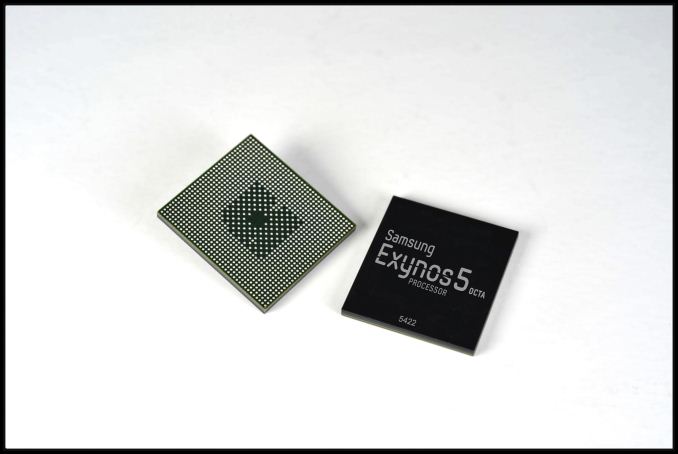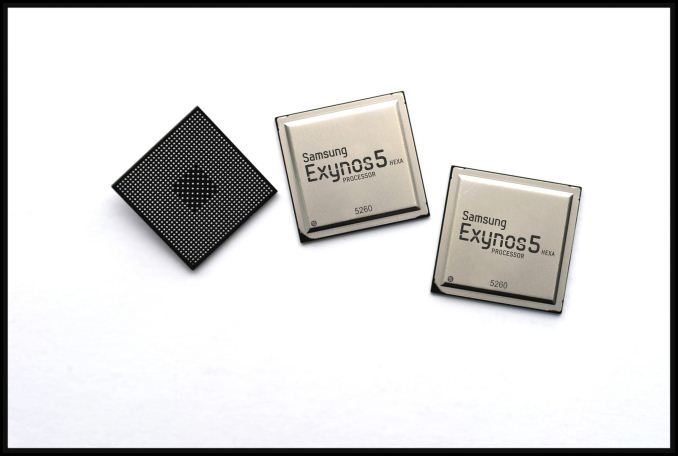Samsung's Exynos 5422 & The Ideal big.LITTLE: Exynos 5 Hexa (5260)
by Anand Lal Shimpi on February 25, 2014 9:00 PM EST- Posted in
- SoCs
- Samsung
- Smartphones
- Mobile
- Tablets
- exynos 5 octa
- Exynos 5 Hexa

Samsung announced two new mobile SoCs at MWC today. The first is an update to the Exynos 5 Octa with the new Exynos 5422. The 5422 is a mild update to the 5420, which was found in some international variants of the Galaxy Note 3. The new SoC is still built on a 28nm process at Samsung, but enjoys much higher frequencies on both the Cortex A7 and A15 clusters. The two clusters can run their cores at up to 1.5GHz and 2.1GHz, respectively.
The 5422 supports HMP (Heterogeneous Multi-Processing), and Samsung LSI tells us that unlike the 5420 we may actually see this one used with HMP enabled. HMP refers to the ability for the OS to use and schedule threads on all 8 cores at the same time, putting those threads with low performance requirements on the little cores and high performance threads on the big cores.
The GPU is still the same ARM Mali-T628 MP6 from the 5420, running at the same frequency. Samsung does expect the 5422 to ship with updated software (drivers perhaps?) that will improve GPU performance over the 5420.
| Exynos 5 Comparison | ||||||||
| SoC | 5250 | 5260 | 5410 | 5420 | 5422 | |||
| Max Number of Active Cores | 2 | 6 | 4 | 4 (?) | 8 | |||
| CPU Configuration | 2 x Cortex A15 | 2 x Cortex A15 + 4 x Cortex A7 | 4 x Cortex A15 + 4 x Cortex A7 | 4 x Cortex A15 + 4 x Cortex A7 | 4 x Cortex A15 + 4 x Cortex A7 | |||
| A15 Max Clock | 1.7 GHz | 1.7GHz | 1.6GHz | 1.8GHz | 2.1GHz | |||
| A7 Max Clock | - | 1.3GHz | 1.2GHz | 1.3GHz | 1.5GHz | |||
| GPU | ARM Mali-T604 MP4 | ARM Mali-T624 (?) | Imagination PowerVR SGX544MP3 | ARM Mali-T628 MP6 | ARM Mali-T628 MP6 | |||
| Memory Interface | 2 x 32-bit LPDDR3-1600 | 2 x 32-bit LPDDR3-1600 (?) | 2 x 32-bit LPDDR3-1600 | 2 x 32-bit LPDDR3-1866 | 2 x 32-bit LPDDR3-1866 | |||
| Process | 32nm HK+MG | 28nm HK+MG (?) | 28nm HK+MG | 28nm HK+MG | 28nm HK+MG | |||
The launch vehicle for the 5422 is likely the recently announced Galaxy S 5. Although most of what we'll encounter will ship with Qualcomm's Snapdragon 801, we'll likely see some international variants with the 5422. It's also entirely possible that some future Exynos 5422 SGS5 variants will feature an Intel XMM 7160 LTE modem.
The more exciting news however is the new Exynos 5 Hexa, a six-core big.LITTLE HMP SoC. With a design that would make Peter Greenhalgh proud, the Exynos 5260 features two ARM Cortex A15 cores running at up to 1.7GHz and four Cortex A7 cores running at up to 1.3GHz. The result is a six core design that is likely the best balance of performance and low power consumption. HMP is fully supported so a device with the proper scheduler and OS support would be able to use all 6 cores at the same time.
The 5260 feels like the ideal big.LITTLE implemention. I'm not expecting to find the 5260 in many devices, but I absolutely want to test a platform with one in it. If there was ever a real way to evaluate the impact of big.LITTLE, it's Samsung's Exynos 5260.
Samsung didn't announce cache sizes, process node or GPU IP for the 5260. Earlier leaks hinted at an ARM Mali T624 GPU. Samsung's release quotes up to 12.8GB/s of memory bandwidth, which implies a 64-bit wide LPDDR3-1600 interface.











35 Comments
View All Comments
sherlockwing - Tuesday, February 25, 2014 - link
Do you have info on whether these are paired with Intel LTE chips?webmastir - Wednesday, February 26, 2014 - link
I don't think they typically answer questions in comments.xaueious - Tuesday, April 29, 2014 - link
And they did it. Galaxy K Zoom.sherlockwing - Tuesday, February 25, 2014 - link
Nvm, skipped the part where you mentioned Intel LTE.deltatux - Tuesday, February 25, 2014 - link
If the Cortex A7s are meant to be low powered cores, wouldn't it make more sense to have 4 Cortex A15s and then 2 Cortex A7s? Most tasks that won't need a lot of power would be the ones needing a dual core or less, not a quad core. Usually it's the demanding tasks that would take full advantage of the higher core count. The 5260 doesn't really make sense to me.hamsteyr - Tuesday, February 25, 2014 - link
As I know it, the A7's are perfectly fine for day to day tasks, it's only on load times that the Cortex A15's are loaded to ramp up and speed up load times. They're kind of like the Nitro for the processors.A7's perform perfectly fine though, as you'll see from the Motorola Moto G.
jjj - Tuesday, February 25, 2014 - link
You activate individual cores not the entire cluster lol.coder543 - Tuesday, February 25, 2014 - link
Having two high power cores means that you can concentrate on getting the hard work done quickly with the least amount of power expenditure. Having two cores running the show means that they can stay clocked up for longer than a similar quad core processor, being far more effective in the lightly threaded workloads pervasive on mobile platforms. Having four low power cores means that you can do as many background tasks as necessary with minimal power draw. Ideally, you'll probably be using only one or two of those cores, but you can still get a significant amount done with all four before needing two switch up to two Cortex A15s and really amp up your power draw. I'd imagine that all four Cortex A7s would run in less power envelope than the two Cortex A15s.kpb321 - Tuesday, February 25, 2014 - link
I think the 2x A15 4x A7 split makes sense. Everything I've seen for phone work loads says that it's very uncommon to have more than 2 heavily loaded cores with the 3rd and 4th cores usually being used less frequently and often at lower speeds. That makes sense given how hard it is to multithread most things well and doing so across 4+ cores is even harder. Usually the only things that can consistently and easily max out multiple cores like that is things that either aren't done on a phone (software rendering in Max, maya etc) or are done with dedicated hardware like compression. On the other hand a phone is full of low performance background tasks like checking for updates, sending and receiving messages, streaming music, etc. that are perfect for an A7fteoath64 - Wednesday, February 26, 2014 - link
The Hexacore seems to have one A7 core too many. I would go for a PentaCore config with three A7 cores but one of the A7 cores dedicated to I/O processing. Solely so and the scheduler should be aware of it. This way the twin A15 has a perfect A7 shadow core to offload to. Minimising the cache snoops. With I/O tuned to a dedicated A7 core, it becomes a simpler SoC.